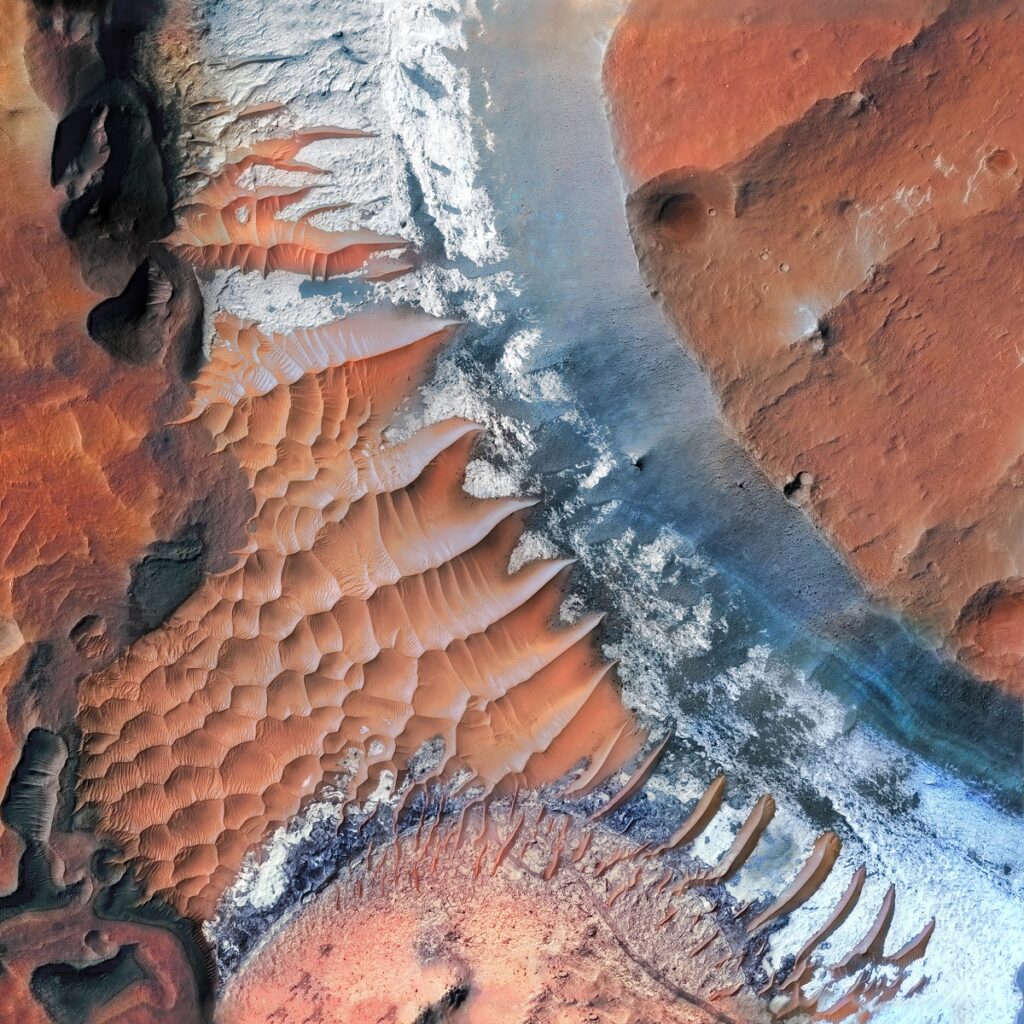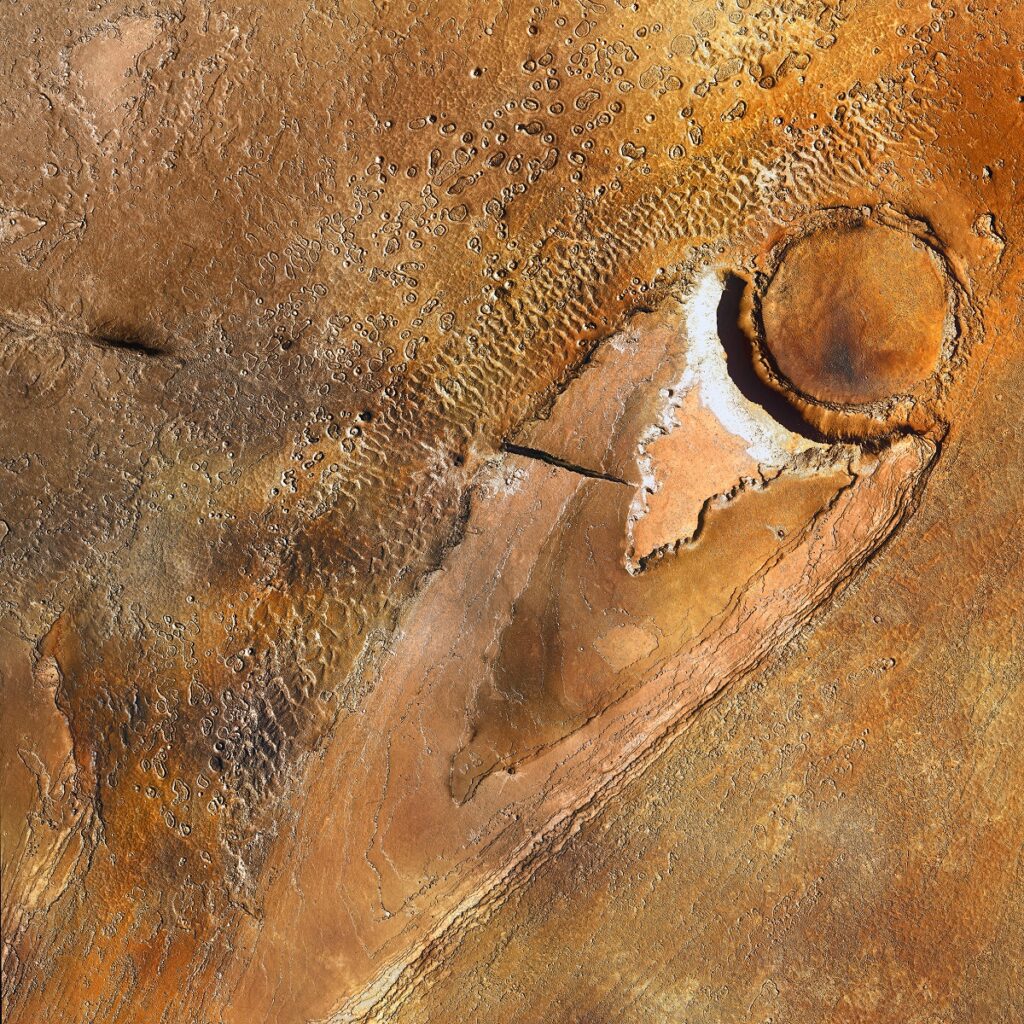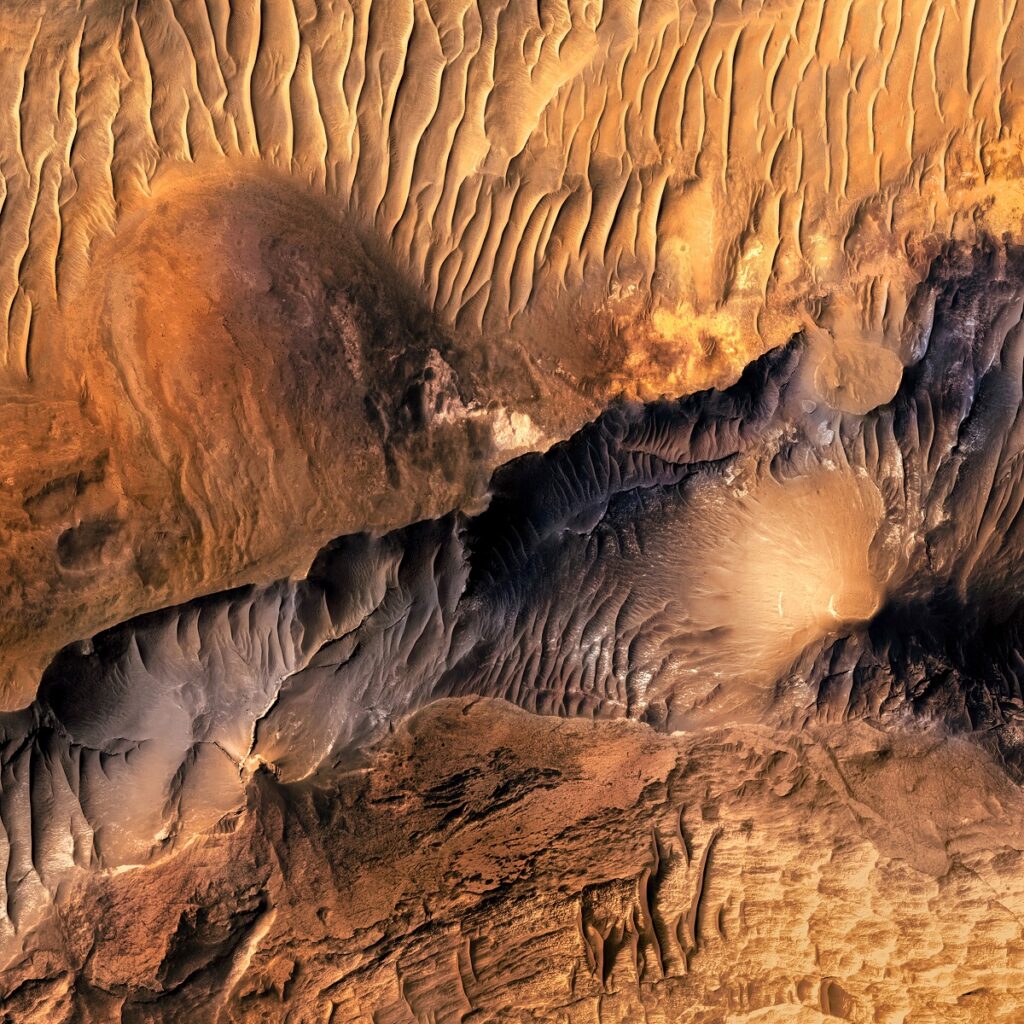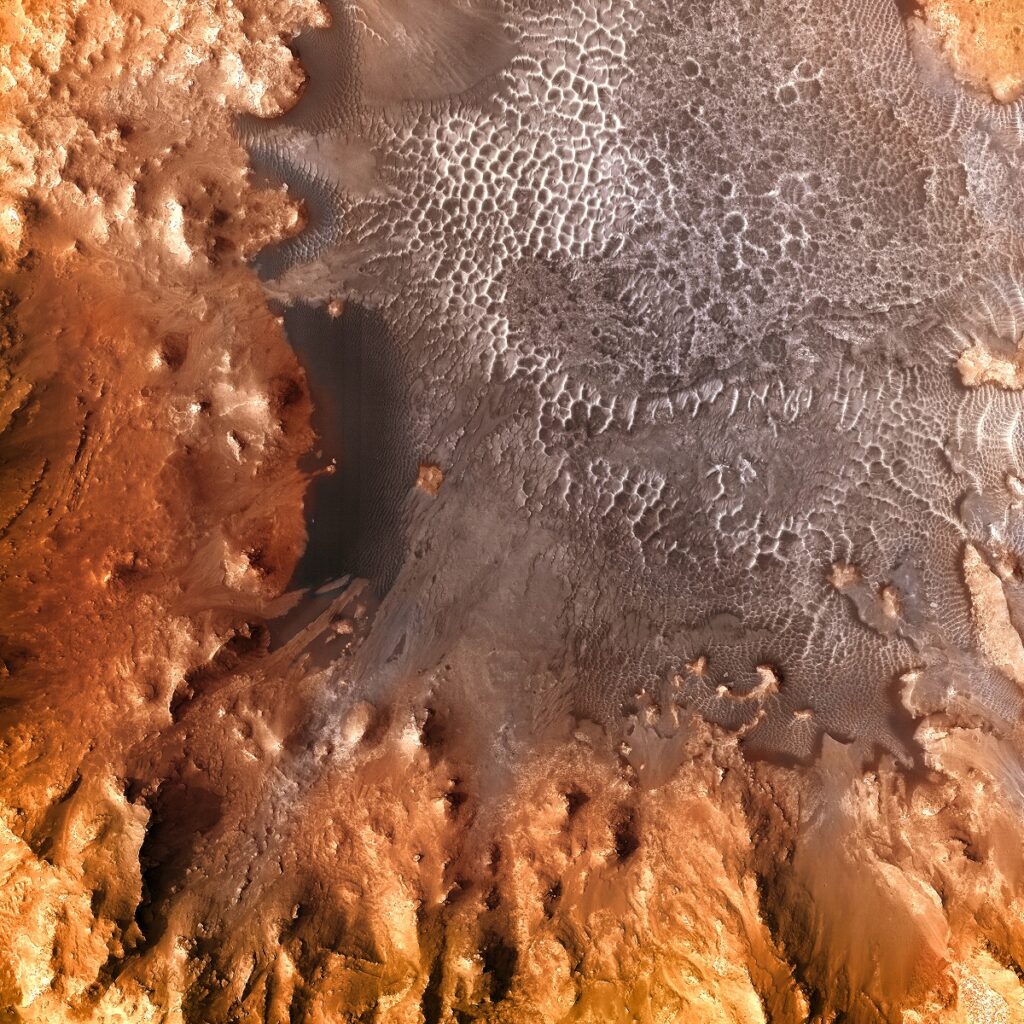Top 10 Largest Caves on Mars
Top 10 Largest Caves on Mars
WhiteClouds Builds 3D Marscapes and Canvas Prints
Did you know we make
custom
8K Mars Canvas Prints

and
3D Marscapes
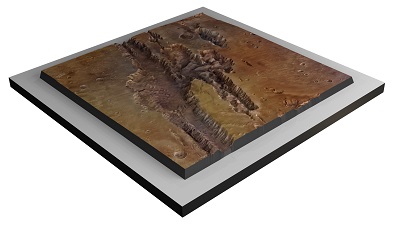
Are you an armchair astronaut or a space aficionado? Then buckle up for an awe-inspiring, heart-pounding odyssey beneath the Martian crust. Mars isn’t just red plains and towering volcanoes; it’s also home to a stunning subterranean world, full of natural mazes and geological wonders that defy imagination. Whether you’re a scientist eager to explore the potential for life on other planets or an explorer in search of extraterrestrial adventure, these Martian caves are your passport to an underground universe teeming with possibilities. In this ultimate guide, we will dive deep into the top 10 largest caves on Mars—magnificent realms that offer unprecedented insights into the planet’s geology, potential resources, and maybe even its past habitability.
#1: Hellas Basin Caves (11,482 Feet)
The Hellas Basin Caves, located in the Hellas Planitia, are a wonder to behold, akin to a sprawling subterranean metropolis stretching beneath the Martian surface. This underground labyrinth, complete with its network of serpentine tunnels and magnificent chambers, rivals even the most intricate natural cave systems on Earth. Researchers find themselves particularly enthralled by these subterranean expanses, surmising that they could harbor a trove of undiscovered secrets. Among the numerous hypotheses is the tantalizing idea that these expansive caves might house ancient ice deposits, preserving water from a bygone Martian era. Moreover, the possibility of finding microbial life forms in this secluded habitat has added an additional layer of excitement to these caves’ allure. The scientific consensus increasingly suggests that these underground networks could serve as biomes, allowing life to thrive away from the planet’s inhospitable surface conditions. Can you imagine the intrepid explorers of the future navigating through this elaborate maze, perhaps uncovering secrets as mind-bending as the mythological labyrinth of Minos?
#2: Olympus Mons Lava Tubes (8,202 Feet)
Hidden within the recesses of Olympus Mons—the behemoth that stands as the largest volcano in our solar system—are the Olympus Mons Lava Tubes. These aren’t your run-of-the-mill lava tubes; they are so cavernous that entire skyscrapers could fit comfortably within their hollow cores. Their formation is just as grandiose as their scale. When Olympus Mons was still an active volcano, torrents of molten lava flowed at incredible speeds, creating these majestic subterranean channels as they cooled and hardened. The scientific community is electrified by these natural wonders, and for a multitude of reasons. Not only do these tubes offer an unprecedented opportunity to delve into the volcanic history of Mars, but they also present potential habitats for future Martian settlers. These lava tubes could act as a natural defense against Mars’ extreme temperatures and radiation, essentially functioning as pre-fabricated shelters. Could you visualize the first human cities on Mars, their skyscrapers nestling into these ancient lava tubes, protected from the harsh Martian elements?
#3: Arsia Mons Caves (5,906 Feet)
Situated at dizzying elevations on the Arsia Mons volcano, these caves are a marvel to behold, affording panoramic vistas of the Martian landscape that are simply breathtaking. Imagine standing at the mouth of a cave and peering out over miles and miles of craggy terrains, sweeping plains, and perhaps catching sight of a brewing Martian storm in the distant horizon. On extraordinarily clear Martian days, the visibility can be so spectacular that you might see intricate storm systems taking shape far away, a meteorological ballet that has always intrigued scientists. These unique high-altitude caves are a source of endless fascination and excitement among researchers, who believe they could serve as unparalleled natural observatories on Mars. Situated far above much of the planet’s atmospheric disturbances, these caves have the potential to offer unobstructed views of celestial events, making them a treasure trove for future astronomical studies that could be conducted with minimal interference from the planet’s atmosphere.
#4: Coprates Chasma Caves (4,921 Feet)
Tucked away within the dramatic folds of Valles Marineris, one of the most striking canyon systems on Mars, the Coprates Chasma Caves are nothing short of a geological goldmine. These caverns present a unique, isolated ecosystem that could act as a natural time capsule, possibly safeguarding undiscovered Martian history within its depths. Because of their secluded positioning far from surface disturbances, scientists have proposed that these caves could be perfect locations for preserving ancient Martian relics, should they exist. The thrilling possibility of these caves housing fossilized remnants of long-extinct Martian species or even petrified evidence of primeval Martian flora is a notion that has captured the imaginations of researchers worldwide. Just think of the seismic impact on our understanding of life and planetary evolution if a mission to these mysterious caves were to unearth such monumental discoveries. It would be a groundbreaking event, sending reverberations through the scientific community and reshaping our comprehension of life’s existence elsewhere in the cosmos.
#5: Terra Cimmeria Caves (4,265 Feet)
These are more than just gaping dark voids; they are some of the darkest, most enigmatic places on the entirety of the Martian landscape. In these blackened bowers, sunlight becomes a rare commodity, barely trickling in to illuminate the cavernous depths. This extreme scarcity of light has led to intriguing speculations that these caves could serve as sanctuaries for previously undiscovered forms of extremophile microbial life, uniquely adapted to survive in such pitch-black conditions. The notion that such life forms could exist here has electrified the scientific community, propelling Terra Cimmeria Caves into the spotlight. As a result, numerous ambitious robotic missions are being planned, each designed with the objective of plumbing these inky depths to unveil whatever secrets they may be hiding.
#6: Gale Crater Caves (3,281 Feet)
Nestled within the well-studied Gale Crater, these caves function as a sort of open-access library, storing geological records of the Martian past like volumes on dusty shelves. Researchers are particularly excited about the possibility that the intricate sedimentary layers within these caves could provide a chronological narrative, detailing Mars’ transition from its once river-laden, water-rich environment to its current, dry and desolate state. The walls of these caves are not just mute witnesses; they may actively harbor physical sedimentary clues that capture snapshots of historic water flow or shifting wind patterns. In this sense, the Gale Crater Caves stand as a living, albeit silent, museum of Martian history, eagerly waiting to divulge their secrets to future expeditions.
#7: Echus Chasma Caves (2,625 Feet)
Believed to have been sculpted by what was once the largest waterfall in the solar system, the Echus Chasma Caves are an explorer’s fantasy and a scientist’s riddle rolled into one. Though the monumental falls have long since evaporated, leaving behind only echoes of their once thunderous roar, the atmosphere within these caves is one of haunting serenity. This silence, however, teases the mind with possibilities of what could still be hidden in unexplored corners or submerged caverns that have yet to be discovered. The prospect of discovering concealed underwater chambers, or even remnants of the ancient waterfall’s might, add layers of intrigue and promise to these mysterious caves, making them prime targets for future investigative missions.
#8: Pavonis Mons Caves (2,297 Feet)
Situated conveniently near the Martian equator, the Pavonis Mons Caves present a compelling argument for being the landing sites of future human expeditions to Mars. Unlike the more inhospitable regions, their equatorial location offers easier accessibility and a somewhat more stable thermal environment, potentially minimizing the challenges posed by the planet’s notorious temperature swings. This “prime real estate” is not just attractive for its location; it’s also an excellent contender for harnessing solar power, given that equatorial regions receive consistent sunlight. Scientists and engineers are already buzzing about the possibility of these caves serving as the cradle for the first Martian colonies, complete with solar arrays to power the fledgling human presence.
#9: Tharsis Tholus Caves (1,640 Feet)
The Tharsis Tholus Caves stand as enigmatic vaults, far removed from other known Martian cave systems. Their secluded nature has kept them relatively unexplored, which makes them all the more tantalizing for scientists and adventurers alike. With their yet-to-be-discovered secrets, these caves are like the treasure troves of Martian geology—undisturbed vaults that might be holding invaluable geological artifacts or even signs of past microbial life. These mysterious chambers beckon the brave souls willing to venture into their dark expanses, promising the glory of being the first to unveil their concealed wonders.
#10: Utopia Planitia Caves (984 Feet)
Don’t let their modest size fool you—the Utopia Planitia Caves punch far above their weight in terms of scientific importance. These caves, located in Mars’ colder northern hemisphere, could very well be time capsules from a wetter, perhaps more life-friendly Martian past. Researchers hypothesize that these caverns might have functioned as natural reservoirs during eras when Mars had a more hospitable climate. The remaining ice and possible mineral deposits within could offer unprecedented insights into the Red Planet’s climatic history. Unlocking these clues could be akin to finding the Rosetta Stone for understanding Mars’ environmental transformations over countless millennia.
And there you have it! From the immense, sprawling underworlds to the potential subterranean waterfalls, these captivating Martian caves beckon with their untold stories and unimaginable possibilities. As we take steps towards the next phase of Martian exploration, these cavernous wonders stand as both a challenge and an invitation to unearth the hidden layers of this complex, multifaceted planet. Whether as potential habitats for future settlers or as treasure troves of geological and biological data, these caves offer a glimpse into a Martian world far removed from the barren, inhospitable surface we often imagine. Keep dreaming, keep exploring, and maybe one day we’ll unlock the secrets that these Martian caves hold in their dark, echoing chambers.
Check out our 3D Mars Learning Center for more information on Mars and its tallest mountains. You can also learn more at: NASA Mars Exploration.
More About Mars
Contact us today to learn more about our 3D services and how we can help you achieve your goals.
